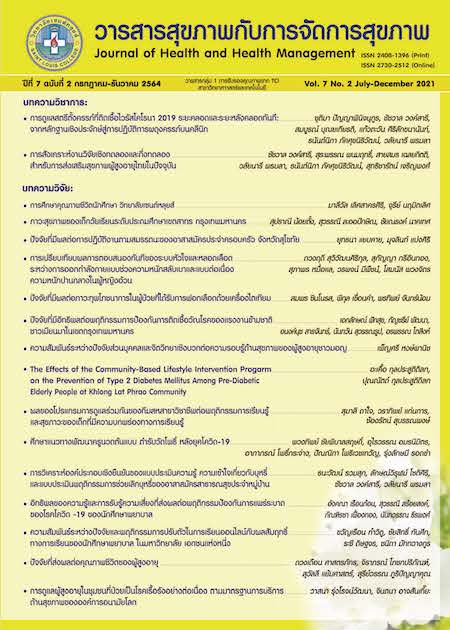Factors Affecting The Quality Of Life In Elderly
Keywords:
quality of life, elderlyAbstract
Descriptive research aimed 1) to compare the quality of life in the elderly with different age, educational level, income, family characteristics and membership of the elderly club, 2) to find the power to predict the quality of life in the elderly. 200 elderly were sample group, aged 60 years with caretaker and over by randomly selecting 10 out of 24 communities in Sathorn area. There were eight tools, including stress and mental health assessments of the Department of Mental Health 2 sets with reliability equal .720 and .852. Quality of life assessment form of the World Health Organization, 1 set had a reliability equal .846, and the research team developed another 5 sets as questionnaires on a 5-level estimation scale to determine the quality of these 5 tools through 3 experts, checking the consistency of the questions with the measurement objectives, got IOC=.67-1.00. Find reliability by using Cronbach's alpha coefficient was family relationship, self-esteem, religious doctrine, internal-external locus of control, society participation, which was .845, .896, .810, .813 and .927 respectively. The statistical analysis was t-test, F-test, correlation coefficient and multiple regression stepwise. The results were 1) elderly 60-69 years had better quality of life than those 80-89 years old. Higher education levels had better quality of life than low education levels. The quality of life of the single-family elderly was better than the extended family. There was no difference in quality of life of income and the elderly club membership. 2) The power to predict the quality of life of the elderly, it was found that all psychological factors predicted the quality of life of the elderly were 26.0% (R2=.260, t=2.93,), were self-esteem (β=.31) stress (β=-.23) and social participation (β= .19) statistically significant at the .01 level.
References
กรมสุขภาพจิต กระทรวงสาธารณสุข. (2563). ก้าวย่างของประเทศไทย สู่‘สังคมผู้สูงอายุ’อย่างสมบูรณ์แบบ.สืบค้นเมื่อ 25 เมษายน 2564.จาก https://www.dmh.go.th
กรมการศาสนา. (2564). คุณธรรมจริยธรรมพื้นฐานและหลักคําสอนทางศาสนาของ ๕ ศาสนาที่ส่งเสริมให้คนเป็นคนดีและเสริมสร้างสังคมให้สงบสุขร่มเย็น. กระทรวงวัฒนธรรม. สืบค้นจาก https://www.nmpc.go.th.
จินตนา ยูนิพันธ์. (2551). ทฤษฎีการพยาบาล. กรุงเทพฯ: จุฬาลงกรณ์มหาวิทยาลัย
เจษฎา นกน้อย, และ วรรณภรณ์ บริพันธ์. (2560). คุณภาพชีวิตของผู้สูงอายุในจังหวัดสงขลา. วารสารมหาวิทยาลัยนราธิวาสราชนครินทร์, 9(3), 94-105.
ณัฏฐ์ฐิตตา เทวาเลิศสกุล, วณิฎา ศิริวรสกุล, และชัชสรัญ รอดยิ้ม. (2559). แนวทางการพัฒนาผู้สูงอายุจากภาระให้เป็นพลังกรณีศึกษาเทศบาลนครรังสิต.วารสารวิชาการมนุษยศาสตร์สังคมศาสตร์และศิลปะ, 9(1), 529-545.
เด่น นวลไธสง. (2556). ปัจจัยที่มีความสัมพันธ์กับระดับคุณภาพชีวิตผู้สูงอายุในเขตความรับผิดชอบขององค์การบริหารส่วนตำบลวังไม้ขอนอำเภอสวรรคโลก จังหวัดสุโขทัย.การประชุมวิชาการราชภัฎนครสวรรค์วิชาการ ครั้งที่ 1.นครสวรรค์: มหาวิทยาลัยราชภัฎนครสวรรค์
นันทิญา อังกินันท์. (2546). คุณภาพชีวิตผู้สูงอายุในชมรมผู้สูงอายุเขตบางกอกน้อยกรุงเทพมหานคร.(หลักสูตรปริญญาศิลปศาสตรมหาบัณฑิตสาขาไทยศึกษา). กรุงเทพฯ:สถาบันราชภัฏธนบุรี.
พาริณี สุกใส, สุธรรม นันทมงคลชัย, ศุภชัย ปิ ติกุลตัง, โชคชัย หมั่นแสวงทรัพย์, พิมพ์สุรางค์ เตชะบุญเสริมศักดิ์. (2561). ปัจจัยที่มีอิทธิพลต่อสุขภาพจิตของผู้สูงอายุในเมือง จังหวัดราชบุรี.วารสารวิชาการสาธารณสุข,27(5) 809-818.
พัชราภรณ์ พัฒนะ. (2560). คุณภาพชีวิตของผู้สูงอายุในศูนย์การเรียนรู้การดูแลผู้สูงอายุ เขตสุขภาพที่ 4. พุทธชินราชเวชสาร, 36(1), 21-33.
มันโซร์ ดอเลาะ. (2559).ปัจจัยทีมีความสัมพันธ์กับคุณภาพชีวิตของผู้สูงอายุในจังหวัดชายแดนภาคใต้กรณีศึกษา: ตําบลบาละ อําเภอกาบัง จังหวัดยะลา (วิทยาศาสตรมหาบัณฑิต สาขาวิชาสาธารณสุขศาสตร์). ยะลา: มหาวิทยาลัยราชภัฏยะลา.
ยุพา รูปงาม. (2559). การมีส่วนร่วมของข้าราชการสำนักงบประมาณในการปฏิรูประบบราชการ. กรุงเทพฯ: สถาบันบัณฑิตพัฒนบริหารศาสตร์.
สโรชา อยู่ยงสินธุ์ และสุจิตรา สุคนธทรัพย์. (2558). ความสัมพันธ์ระหว่างความเชื่ออำนาจควบคุมทางสุขภาพและพฤติกรรมสุขภาพ และคุณภาพชีวิตของผู้สูงอายุในภาคตะวันออกเฉียงเหนือ. วารสารวิทยาศาสตร์การกีฬาและสุขภาพ, 16(2), 73-86.
สมพร ชิโนรส และชุติมา ดีปัญญา. (2562). ปัจจัยที่มีผลต่อคุณภาพชีวิตของผู้ป่วยที่ได้รับการฟอกเลือดด้วยเครื่องไตเทียม.วารสารสุขภาพกับการจัดการสุขภาพ, 5(2), 54-67
Maslow, A. H. (1943). A theory of human motivation. Psychological review, 50(4), 370-396.
Rotter, J. B. (1966). Generalized expectancies for internal versus external control of rein forcement. Psychological monographs: General and applied, 80(1), 1–28.
Prakash, S., & Kumar, S. (2019). Perceived stress and quality of life of elderly living separately from their adult children-a cross-sectional comparative study. International Journal of Health Sciences and Research (JHSR), 9(4), 7-13.
UNESCO. (1981). Quality of life. An Orientation of Population Education. Bangkok: UNESCO
Downloads
Published
How to Cite
Issue
Section
License
Copyright (c) 2021 Journal of health and health management

This work is licensed under a Creative Commons Attribution-NonCommercial-NoDerivatives 4.0 International License.




